Endovenous Laser Therapy (EVLT)
Endovenous laser therapy (EVLT or ELT) is synonymous to endovenous laser ablation (EVLA). It is one of the many procedures we use at the San Francisco Vein Center to treat varicose veins. This is a minimally invasive procedure that we perform in the office. It requires no general anesthesia and allows the patient to walk out of the office after the procedure and resume normal activities soon after. It is safe, effective, and takes about an hour. EVLT or EVLA is a vast improvement over the past traditional method of removing varicose veins called “vein stripping”.
Candidates and preparation
Because endovenous laser therapy is minimally invasive, there is little to prepare for the procedure. It is necessary for the surgeon to perform a venous ultrasound to determine if the patient has venous insufficiency. This is the primary cause of varicose veins. The vascular surgeon then uses ultrasound to map out the vein or veins that will be treated with laser. General anesthesia is not necessary for laser ablation although patients may sometimes take something to relax.
Procedure

Recovery
There are very few restrictions with recovering after the Endovenous laser therapy procedure. One of the few is to stay away from highly strenuous or high impact exercise for a few days. There are a few other key factors to follow for optimal recovery after laser ablation.
- We encourage patients to exercise and walk immediately after treatment. Walking frequently and daily is important and helps recovery.
- Wearing compression stockings is also important. The patient should wear them for about two weeks. They are not necessary while sleeping.
- Avoid sitting for long periods of time.
Risks and success rates
Laser vein ablation is a very low risk procedure. Endovenous laser therapy patients can experience some bruising and discomfort for a few days to weeks. Sometimes patients experience redness or irritation around the treatment site. Deep vein thrombosis is a one of the main risks the be aware of. There is about a 1% risk. This condition happens when a blood clot forms in the vein. Although rare, it can become serious if it dislodges and travels to the lungs. When this happens, it needs to be immediately treated with blood thinners. Following the recovery regime of wearing compression stockings and walking frequently helps to reduce these risks.
The initial success rate for laser ablation is about 99%. However, over time there is a 5% to 10% chance of recurrence. Because it is minimally invasive and low risk, patients who experience recurrence can choose to perform the procedure again.
New technology and improvements

At the San Francisco Vein Center, we offer both endovenous laser ablation and radiofrequency ablation. We consider vein size, vein depth, and many other factors when choosing a treatment for our patients. We also discuss the options with our patients and take in to account patient preference. That way we can provide a custom treatment plan that best fits the needs of our patients and provide the best results possible.
